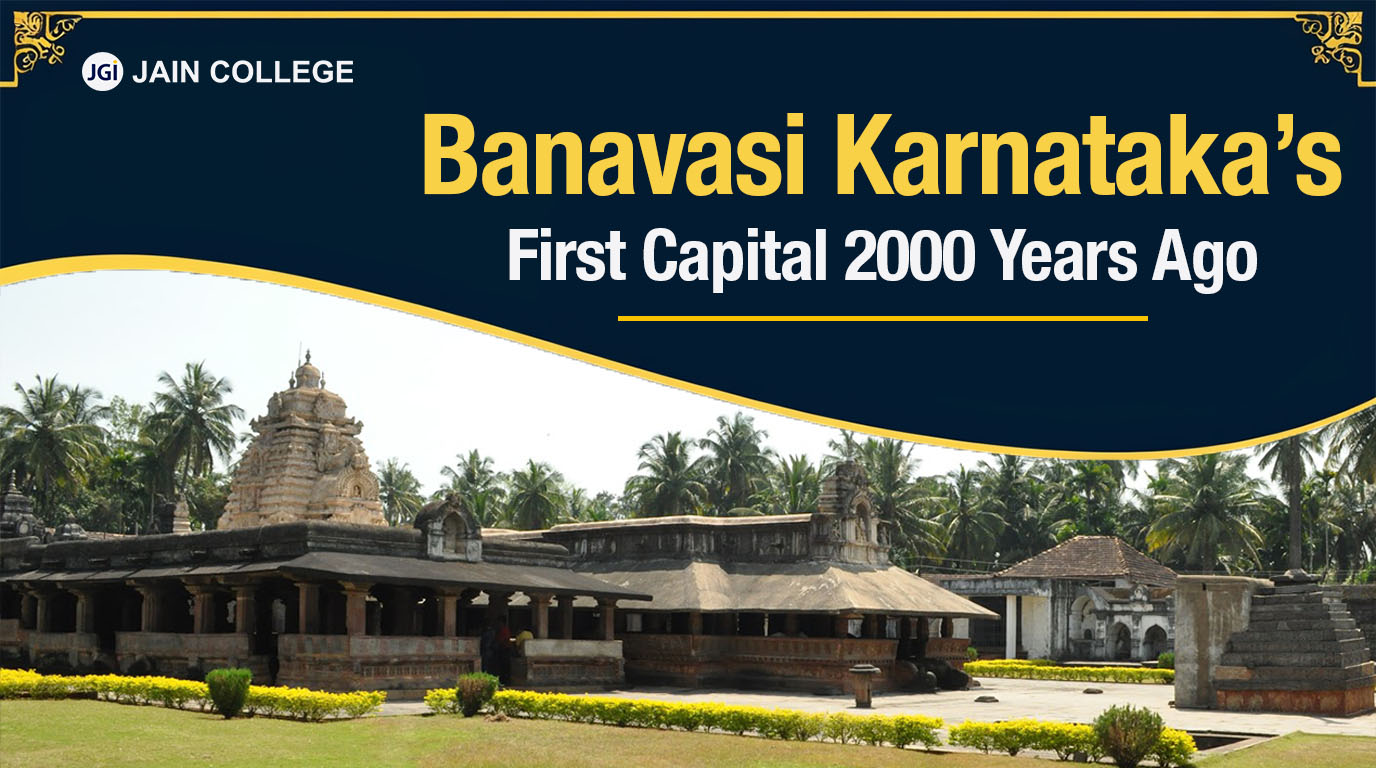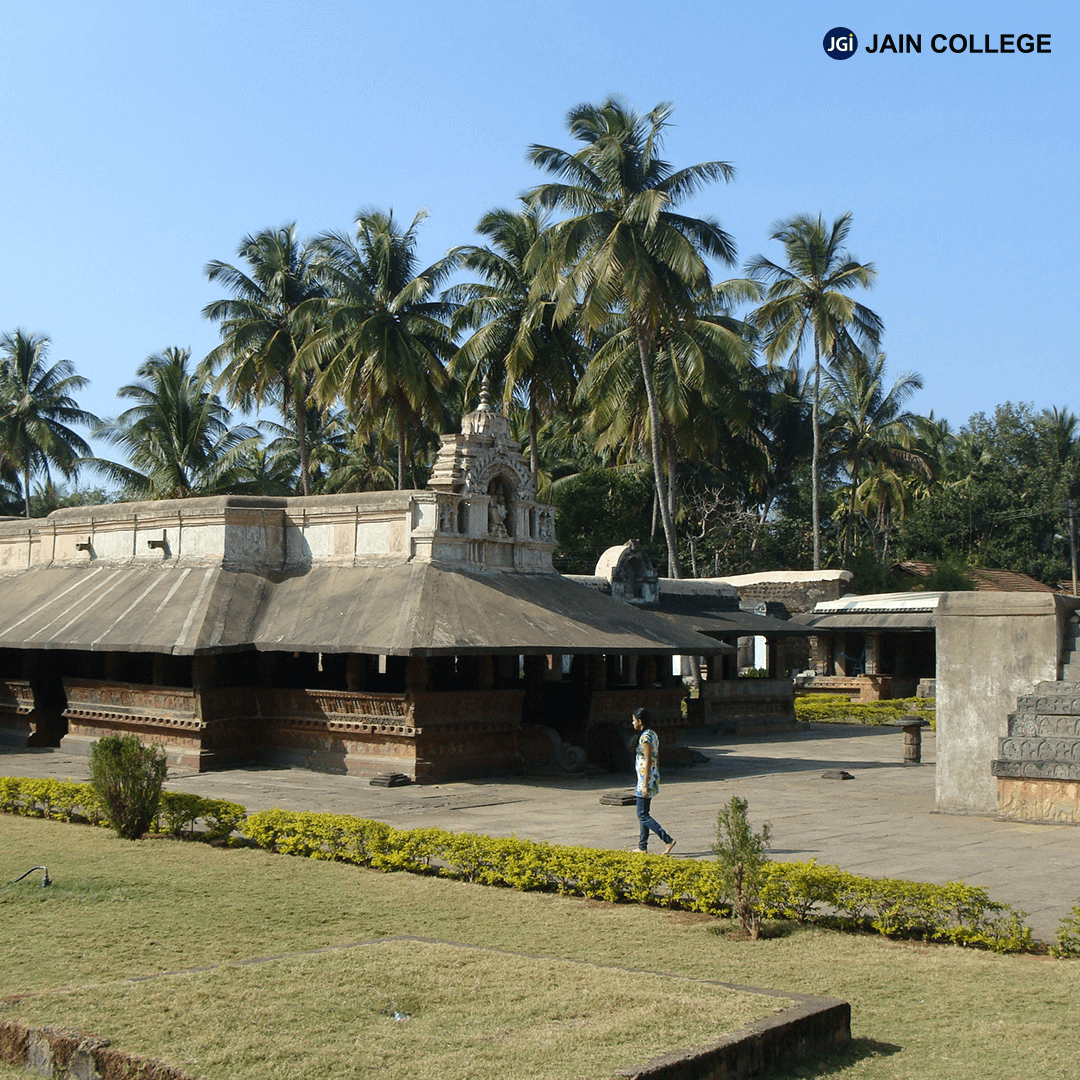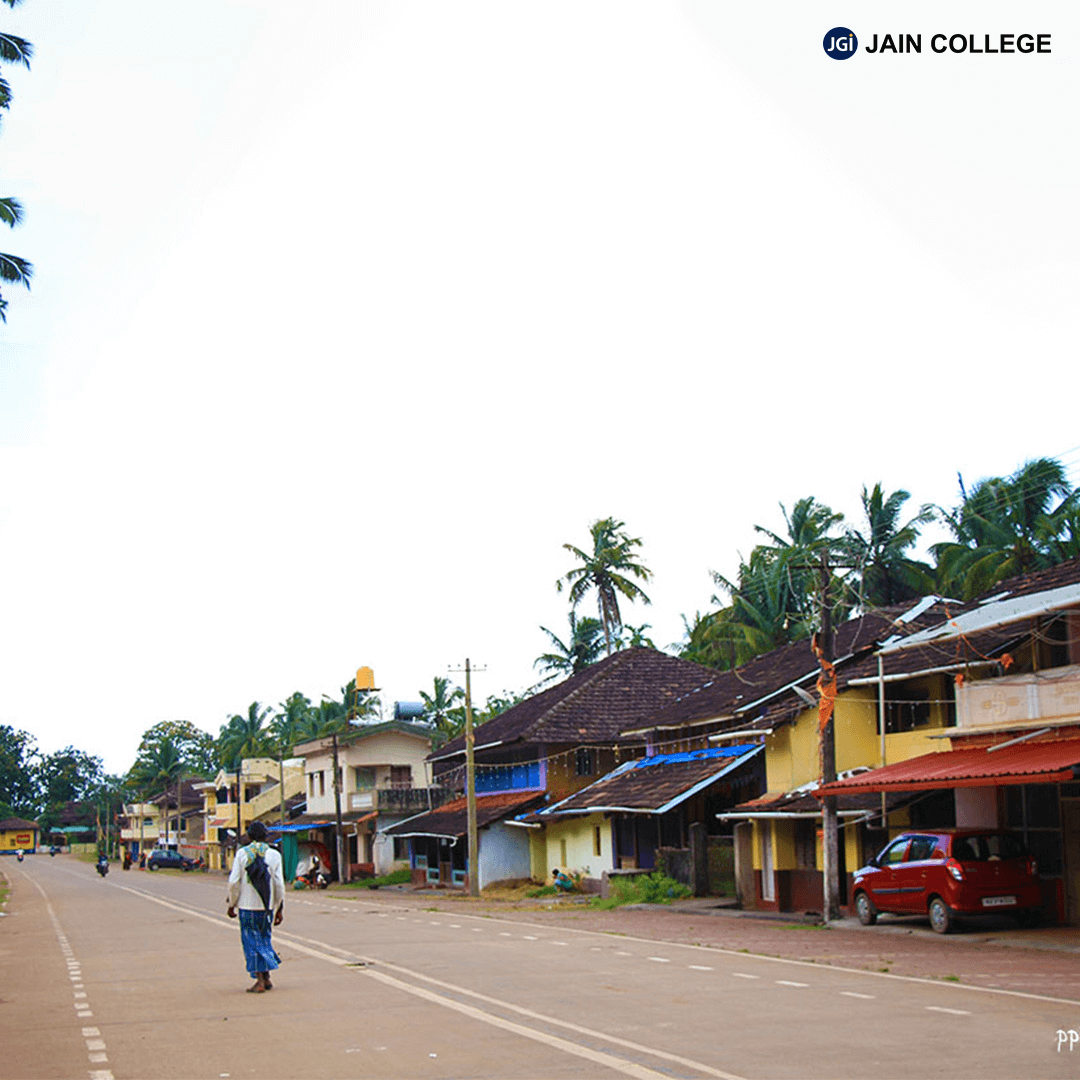
Ancient Heritage: Banavasi is one of the oldest towns in South India, with a history dating back over 2,000 years.
Kadamba Dynasty Capital: Banavasi served as the capital of the Kadamba Dynasty, Karnataka's first indigenous ruling dynasty.
Madhukeshwara Temple: The iconic Madhukeshwara Temple, dedicated to Lord Shiva, is known for its unique honey-colored Lingam and intricate carvings.
Mention in Literature: Renowned Sanskrit poet Kalidasa referenced Banavasi in his famous work Meghaduta, highlighting its natural beauty and cultural significance.
Rich in Inscriptions: The region is home to several ancient inscriptions, including one of Karnataka's oldest Kannada inscriptions dating back to the 5th century.
Architectural Marvels: Banavasi is adorned with impressive stone sculptures, temple ruins, and traditional wooden carvings showcasing exceptional craftsmanship.
Lush Plantations: The town is surrounded by scenic areca nut plantations, contributing to its serene and green landscape.
Cultural Hub: Banavasi hosts vibrant festivals such as Kadambotsava and the Madhukeshwara Jatre, celebrating local traditions and art forms.
Tourism Hotspot: Besides its historic charm, Banavasi is a central point for exploring nearby attractions like Jog Falls, Sirsi, and Yana Caves.
Preserved Traditions: The locals of Banavasi continue to uphold age-old customs, including unique crafts, folk performances, and temple rituals, offering visitors an authentic cultural experience.
Banavasi is an ancient town near Sirsi in northern Karnataka's heart. This historic town is honoured to have been the first capital of the Kadamba dynasty over 2,000 years ago.
Banavasi is a historic temple town with great historical and cultural importance. Banavasi is an ancient town situated in the Uttara Kannada district of Karnataka. Located within the Western Ghats of northern Karnataka, Banavasi is one of the earliest towns in the state and is recognised for its profound ties to Karnataka’s ancient dynasties and religious customs. Nestled near Sirsi, in the centre of northern Karnataka, this old town dates back to the Middle Ages.
Banavasi , the ancient town, takes pride in being the first capital of the Kadamba dynasty, which dates back over 2,000 years.
The Kadamba dynasty ruled the modern-day Karnataka state from the 4th to the 6th century CE, during which Banavasi played a crucial role in shaping the early history of Karnataka state, particularly in promoting the Kannada language and culture.
The remains of ancient temples, memoranda, and architectural structures offer a glimpse into the majesty or gloriousness of this city and deliver valuable insights into its rich legacy.
Keep Reading!
Table Of Contents:
Banavasi, in northern Karnataka, is a key site for understanding the region's early historic period. Historical records refer to it as Vanavasa, Vanavasaka, or Vanavasi, with Vaijayanti or Vaijayantipura being the most common names in inscriptions by Gautamiputra Satakarni and the Kadambas.
As the first capital of the Kadamba Dynasty (4th–6th centuries CE), Banavasi holds rich historical significance. Though no longer a bustling urban centre, it still remain a peaceful village with remnants of its glorious past.
The Madhukeshwara Temple, built in the 9th century by the Kadamba kings, stands as the most prominent among Banavasi’s 20+ temples, earning it a reputation as a spiritual haven.
 The Madhukeshwara Temple, dedicated to Lord Shiva, is the most renowned site in Banavasi. This temple features exquisite inscriptions in Kannada and is regarded as one of the ancient temples in the area, showcasing the architectural style of its period.
The Madhukeshwara Temple, dedicated to Lord Shiva, is the most renowned site in Banavasi. This temple features exquisite inscriptions in Kannada and is regarded as one of the ancient temples in the area, showcasing the architectural style of its period.Various other ancient ruins and inscriptions can be discovered throughout the region besides the Madhukeshwara Temple. These remains showcase the advanced urban planning of the Kadamba capital, featuring buildings probably utilised for religious and administrative functions.
Banavasi: Karnataka's Ancient Gem
Banavasi is one of the oldest towns in Karnataka and is recognised as the first capital of ancient Karnataka, ruled by the Kadamba Dynasty.
Nestled along the sacred Varadha River, Banavasi is steeped in spiritual significance. For the devout, this peaceful town is believed to be heaven on Earth, with over twenty temples adding to its divine charm.
Mayurasharma founded the Kadamba dynasty in the 4th century CE, making Banavasi a thriving capital. The dynasty played a vital role in shaping the region's political and cultural landscape, paving the way for future rulers. During their reign, significant structures such as temples, fortifications, and other architectural wonders were built, contributing to the spread of the Kannada language.
The town is also linked to several influential scholars and leaders. Notably, Sripala, a prominent philosopher and scholar, composed an inscription that still stands in Banavasi today — a valuable historical reference for the Kannada-speaking people.
Banavasi is considered India’s oldest spiritual centre after Varanasi. Known as 'Vanavasaka' in the Mahabharata, it is believed to have existed since 4000 BC. Remarkably, a 5th-century copper coin was recently unearthed here, further solidifying Banavasi's rich historical roots.
How Did Banavasi Become Karnataka's First Capital ?
In the 4th century A.D Mayura Sharma, of the Kadamba Dynasty, chose Banavasi as first capital of Karnataka 2000 years ago and established the first formidable centre of power in Karnataka. Thus, Banavasi was selected as the first capital of ancient Karnataka.
The most crucial element of Banavasi is its impact on Kannada culture. As the defence of the Kadamba dynasty, it was pivotal in promoting the Kannada language and literature. The Kadamba kings were recognised for supporting the arts and culture, transforming Banavasi into a hub for religious and scholarly pursuits.
Architecturally, Banavasi bears the marks of the Kadamba style, which blended local traditions with influences from other parts of India. This can be seen in the construction of temples, royal palaces, and fortifications. The temples often featured intricate carvings and sculptures, which are considered masterpieces of their time.
 Today, Banavasi serves as a significant historical and cultural location that draws those keen on delving into Karnataka’s ancient heritage. This small village remains unchanged mainly due to commercialisation, allowing the traces of history to be observed in its natural setting and making it a perfect destination for history buffs and archaeologists.
Today, Banavasi serves as a significant historical and cultural location that draws those keen on delving into Karnataka’s ancient heritage. This small village remains unchanged mainly due to commercialisation, allowing the traces of history to be observed in its natural setting and making it a perfect destination for history buffs and archaeologists. While it may not enjoy the same fame as other historical cities in India, Banavasi provides a genuine, less-travelled experience for travellers seeking to discover the foundations or those looking to explore the roots of Karnataka's history.
How to Visit Banavasi?
Banavasi is located on the banks of the Varada River in the state of Karnataka. It is 345 km from Bengaluru, the capital city, and 100 km from Karwar, the district centre. Banavasi can be reached:
BY AIR: The nearest airport is Hubli, which is a distance of 100 km from Banavasi or Dabolim (Goa), 245 km from Banavasi. Once you reach the nearby city airport, taxis can be hired at counters inside the airports to reach Banavasi.
BY ROAD: Driving on your transport from Bangalore, the state's capital city, would take seven to eight hours on NH-206.
Sirsi is the nearest town, about 20 km away. Once you reach Sirsi, many local bus services run from Sirsi to Banavasi every half hour, or you can also get a tourist taxi from Sirsi to Banavasi.
BY TRAIN: The nearest train station is at Haveri, 70 km from Banavasi. Several trains from Bengaluru and Mumbai stop at this station.
Once you reach the railway station, you can hire taxis to Banavasi.
Also Read: Tourist places near Bangalore within 100 kms
Here are some key insights about the Ancient City of Banavasi, Karnataka’s first capital from 2,000 years ago:
Banavasi was the first capital of the Kadamba Dynasty, which ruled the region from the 4th to 6th century CE.
Banavasi is situated in the Uttara Kannada district of northern Karnataka, approximately 60 kilometres from Sirsi.
The town is home to the Madhukeshwara Temple, one of the oldest temples in the region, dedicated to Lord Shiva and featuring inscriptions in Kannada.
The Madhukeshwara Temple is a stone-cut structure built in the ancient Dravidian architectural style in 340 AD. It stands as the most prominent surviving structure from the Kadamba Dynasty.
Banavasi features significant inscriptions that provide valuable insights into the region's history, culture, and language, with some inscriptions dating back over 1,500 years.
The Kadamba Dynasty was one of Karnataka's earliest known dynasties and played a crucial role in shaping the region's history.
The Kadambas were great patrons of the arts, and Banavasi became a hub for cultural and intellectual activities, particularly in the development of the Kannada language and literature.
The Kadamba Dynasty was founded by Mayurasharma, who established his capital in Banavasi during the 4th century CE.
The ruins of Banavasi include remnants of Kadamba-era temples, fortifications, and other structures, reflecting the architectural style of the period.
Banavasi’s influence declined after the Kadamba Dynasty was overthrown in the 6th century, and the region later came under the control of dynasties like the Chalukyas.
Today, Banavasi is a quiet village with historical ruins that continue to attract archaeologists and tourists seeking to explore Karnataka’s rich past.
The best time to visit Banavasi is between November and March, when the weather is cooler and ideal for sightseeing.
The Ancient City of Banavasi is an invaluable witness to Karnataka's ancient history. It highlights Karnataka's deep historical roots and provides an intriguing look into a time when culture, religion, and politics were closely linked.
While it may not have the fame of other historic locales, Banavasi is an essential emblem of the Kadamba dynasty's impact on the area's cultural legacy.
With its ancient temples, ruins, and inscriptions, the town remains a key site of historical significance, drawing those who wish to connect with Karnataka’s first capital's origins. Banavasi's heritage endures, keeping alive the essence of a past era for future generations to explore and value.
Stay tuned with JAIN PU College to learn more about the beauty and significance of Banavasi and other historical backgrounds of India's civilization.
Banavasi is located about 60 kilometres from Sirsi in the Uttara Kannada district of northern Karnataka, India.
Mayurasharma or Mayuravarma (reigned 345–365 CE), was the founder of the Kadamba kingdom of Banavasi. He was a Kannada scholar from Talagunda in present-day Shimoga district.
The Madhukeshwara Temple is one of the famous temples of Banavasi city. It was built in the 9th century AD by Kannada's first kingdom, the Kadamba dynasty.
Banavasi was the capital of the Kadamba dynasty, Karnataka's first historical dynasty, around 2,000 years ago. It played a key role in promoting the Kannada language and culture.
The main attractions in Banavasi include the ancient inscriptions, Madhukeshwara Temple and the ruins of Kadamba-era structures, which showcase the architectural style of that period.
The Kadambas ruled from the 4th to the 6th century CE and were known for laying the foundations for the Kannada language, literature, and culture.
The best time to visit Banavasi is between November and March when the weather is pleasant.
Banavasi can be reached either by:
Road: From Sirsi, with regular buses and private transport available
Train: The nearest rail heads are Haveri and Talaguppa, which are about 70 kilometres from Banavasi.
Contrary to more famous ancient cities, Banavasi remains relatively less commercialised, offering a quieter and more authentic experience of Karnataka's ancient past.

JAIN PU College, a part of the renowned JGI Group, is committed to empowering students with quality education.
Beyond academics, the college ensures its online content reflects the same standard of excellence. Every blog and article is meticulously vetted and proofread by subject matter experts to ensure accuracy, relevance, and clarity. From insightful educational topics to engaging discussions, JAIN PU College's content is crafted to inform, inspire, and add value to its readers, reflecting the institution's commitment to intellectual growth and innovation.
View all Blogs